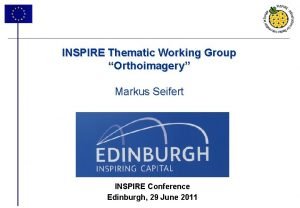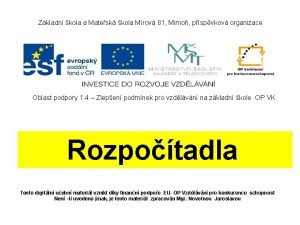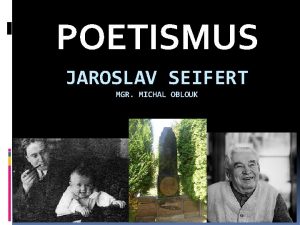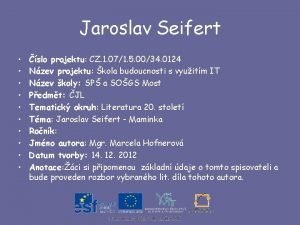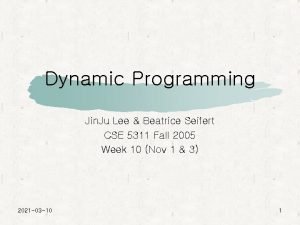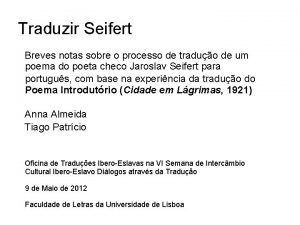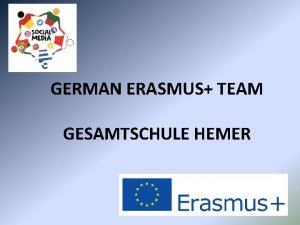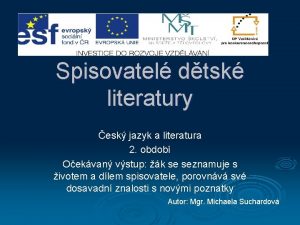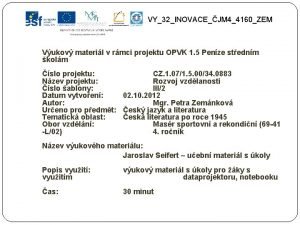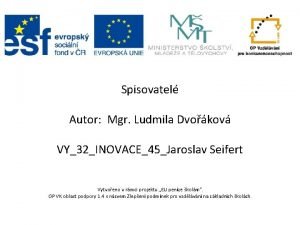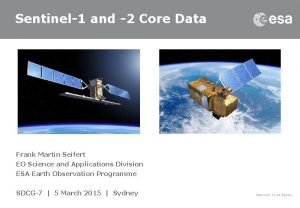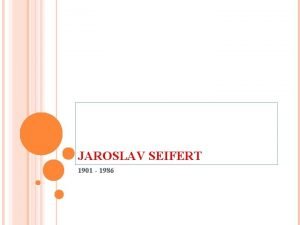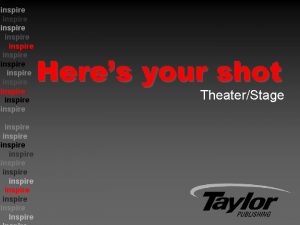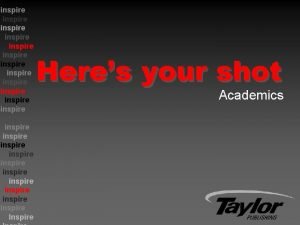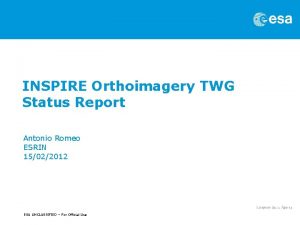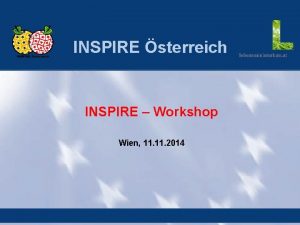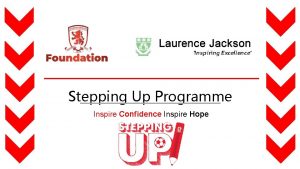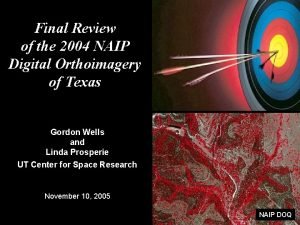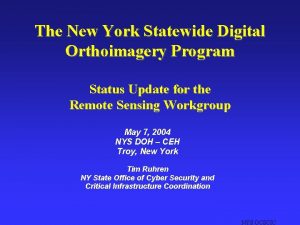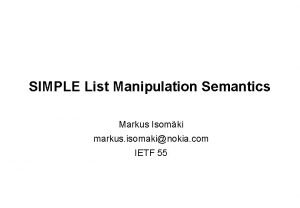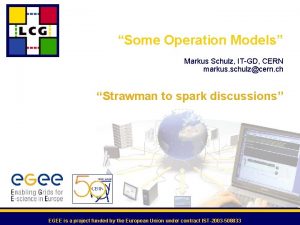INSPIRE Thematic Working Group Orthoimagery Markus Seifert INSPIRE












- Slides: 12

INSPIRE Thematic Working Group “Orthoimagery” Markus Seifert INSPIRE Conference Edinburgh, 29 June 2011 1

People behind Surname Name Ctry Organisation Curtinot Pierre-Yves FR Institut Géographique National Forner Miklós HU Institute of Geodesy, Cartography and Remote Sensing (FÖMI) Holland David UK Ordnance Survey Ilves Risto FI National Land Survey of Finland Kerdiles Hervé JRC-IPSC - Monitoring Agricultural Resource Unit Marchetti Van Bemmelen Romano Pier Giorgio Joost Dario IT ESA Palà Comellas Vicenç ES Institut Cartogràfic de Catalunya Radkov Radko BG Agency for Sustainable Development and Eurointegration - ECOREGIONS Seifert Markus DE Bavarian Administration for Surveying and Geoinformation Trollvik Jon Arne NO Norwegian Mapping Authority Vanderstraete Tony BE AGIV Peces Morera J. José ES Instituto Geográfico Nacional 2 2

Scope • Definition: Geo-referenced image data of the earth’s surface, from either satellite or airborne sensors [Directive 2007/2/EC] • Description: An orthoimage is a raster image that has been geometrically corrected ("orthorectified") to remove distortion caused by camera optics, camera tilt, and differences in elevation. Source is either satellite or air-borne sensors. Data is orthorectified to achieve an accuracy commensurate with a given topographic map equivalent. 3 3

Included Data WITHIN the scope V 2 O V 1 Orthoimagery shall include orthorectified imagery from the infrared, through the visible, to the ultraviolet region of the electromagnetic spectrum derived from: • scanned film positives or negatives • digital airborne sensors (such as frame cameras or push-broom sensors) • satellite imagery of the Earth 4 4

…what is out The scope of the Orthoimagery data specification does not include: • Data from the microwave, X-ray, radio or gamma ray areas of the electromagnetic spectrum. • Li. DAR data (Light Detection And Ranging) • Oblique aerial photography (since this is not orthorectified). Note that orthorectified imagery produced from oblique photography - e. g. as a mosaic – is included. • Terrestrial imagery (e. g. from cameras based on the ground or on road or rail vehicles). • Aerial video imagery. Note that orthorectified images created from video frames is included. • Imagery of the sea bed from underwater sensors (only air-borne and satellite sensors are covered by the specification). • Meteorological satellite imagery (such data is not primarily concerned with imagery of the Earth’s surface). But: This does not prevent data providers from delivering such datasets in conformity with this INSPIRE data specification if they feel the need to do so. 5 5

Achievements How we worked: • 22 teleconferences to keep the process ongoing, normally every 2 weeks • 3 TWG meetings (Southampton, Frascati and Tonsberg) since the kick-off in spring 2010 • 2 workshops additional stakeholders/experts (from esa representing some specific space missions, WCS expert) • Consequent use of the issue tracker JIRA • 2 cross-TWG Meetings (without major overlaps to other TWGs); close cooperation with TWG EL (e. g. European Grid System) • However: Some issues couldn’t be solved. TWG OI provides first suggestion; feedback from testing required 6 6

7 7

Main Content Orthoimagery is modelled as an Orthoimage. Coverage. The main attributes are • Unique identifier, life cycle information (derived from the GCM) • extent • coverages according to ISO 19123, modelled as inheritance • footprint (voidable) • name (voidable) • phenomenon time (voidable) • inherited attribute from „coverages“ (metadata, range. Type etc. ) • associations (also recursive) 8 8

The Concept of Tiling Justification: Requirements of data providers to reduce amount of data. Possibilities: • Usage of specific data encodings (formats, e. g. tiled tiff) NOT part of the data spec • Separation in differernt files in a data base („file based tiling“); NOT part of the data model but potentially part of the encoding section a/ Simple grid with edgematching tiles b/ overlaping tiles c/ varying density of tiles • Conceptual or logical Tiling (z. B. like map sheet grids); IS part of the data spec 9 9

Examples 10 10

Issues • spatial resolution (no restrictions, no requirements) • geometrical representation (should be restricted to Simple Feature Spatial Schema as defined by EN ISO 19125 -1) • updated ISO standards (eg. ISO 19115 Metadata: a new elements of the new - not yet published – standard would be needed) • detailed instructions on how to provide metadata on compliance with minimum data quality requirements and recommendations (general open issue) • conformance and testing • encoding; file based tiling encoding (issue for WCS) • encoding rules should be based on the coverage format encoding extensions for JPEG 2000 and Geo. Tiff that will be developed in OGC Web Services Phase 8 (OWS-8) over summer 2011 11 11

Markus Seifert Facilitator for TWG Orthoimagery Alexandrastr. 4, 80538 Munich, Germany +49 89 2129 1002 markus. seifert@lvg. bayern. de 12
